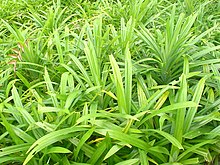Pandan leaf
| Pandanus amaryllifolius | |
|---|---|
 |
|
| Scientific classification | |
| Kingdom: | Plantae |
| (unranked): | Angiosperms |
| (unranked): | Monocots |
| Order: | Pandanales |
| Family: | Pandanaceae |
| Genus: | Pandanus |
| Species: | P. amaryllifolius |
| Binomial name | |
|
Pandanus amaryllifolius Roxb. |
|
| Synonyms | |
|
|
Pandanus amaryllifolius is a tropical plant in the Pandanus (screwpine) genus, which is commonly known as pandan leaves (/ˈpændənˌlivz/), and is used widely in South Asian and Southeast Asian cooking as a flavoring.
The characteristic aroma of pandan is caused by the aroma compound 2-acetyl-1-pyrroline, which may give white bread, jasmine rice and basmati rice (as well as bread flowers Vallaris glabra) their typical smell. The plant is rare in the wild but is widely cultivated. It is an upright, green plant with fan-shaped sprays of long, narrow, blade-like leaves and woody aerial roots. The plant is sterile, with flowers only growing very rarely, and is propagated by cuttings.
In India and Bangladesh it is called Rampe and ketaki respectively, along with the other variety of pandan there (Pandanus fascicularis), and is used to enhance the flavor of pulao, biryani and sweet coconut rice pudding, payesh if basmati rice is not used. It acts as a cheap substitute for basmati fragrance as one can use normal, non-fragrant rice and with the help of pandan the dish tastes and smells like basmati is used. It is called Ambemohor pat in Marathi; Ramba in Tamil, Biriyanikaitha in Malayalam, pandan wangi in Indonesian, hsun hmway (ဆွမ်းမွှေး) in Burmese, pandan in Tagalog, ใบเตย bai tooey in Thai, rampe in Sinhala, ស្លឹកតើយ sleuk toi in Khmer, Daun Pandan in Nonya cooking,Dứa thơm/lá nếp in Vietnamese, 香草 ("Xiāng cǎo") in Chinese and बासमतिया पौधा [bɑːsmət̪ɪjɑː pɑʊd̪ʱɑː] "fragrant plant" in Magahi and Bhojpuri due to its fragrance.
...
Wikipedia
